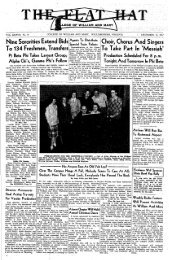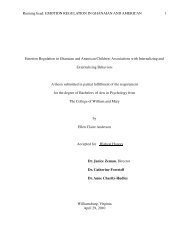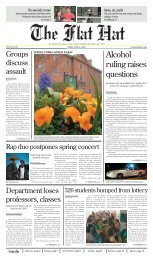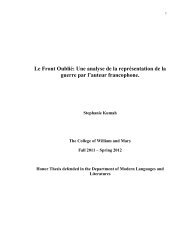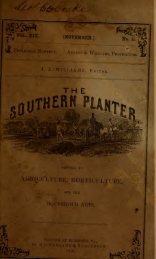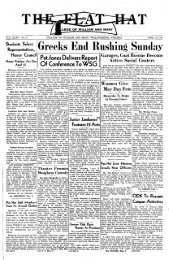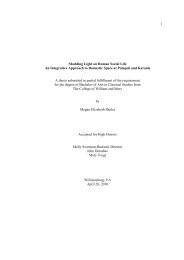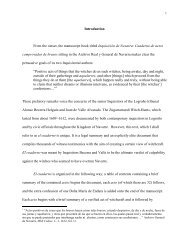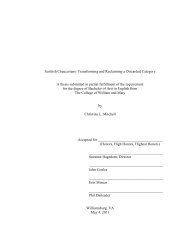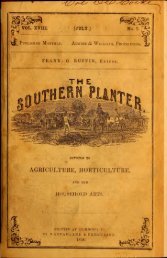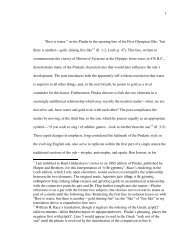Southern planter - The W&M Digital Archive
Southern planter - The W&M Digital Archive
Southern planter - The W&M Digital Archive
You also want an ePaper? Increase the reach of your titles
YUMPU automatically turns print PDFs into web optimized ePapers that Google loves.
446 THE SOUTHERN PLANTER. [July<br />
In the instance to which we have referred,<br />
after the field was checked off for the seed,<br />
a two-horse wagon and three men manured<br />
four acres per day— giving to each hill a<br />
large shovel full of the compost. <strong>The</strong> actual<br />
expense in this case was probably two<br />
dollars per day, but in any case would not<br />
be over four dollars, or one dollar per acre.<br />
Without the manure, the old field might<br />
possibly have yielded 25 bushels to the<br />
acre ; with it, it yielded about 40 bushels.<br />
Difference, 15 bushels, which, only at 33$<br />
cents per bushel, is $5.<br />
All this is clear gain, for the cost of hauling<br />
out and applying the manure is fully repaid<br />
by the condition in which the crop left<br />
the ground for grass.<br />
After this field has lain in grass two or<br />
three years, it will probably be turned over<br />
for another trial, and we will then speak of<br />
it again. Louisville Journal.<br />
Subsoil Plowing.<br />
Before commencing spring work it will<br />
be well to consider which lands should, and<br />
which should not be subsoiled.<br />
From the days of Jethro Tull until within<br />
the last twenty-five or thirty years, the<br />
farmers of England were content, in common<br />
with those of other countries, to stir<br />
the immediate surface of the soil, and were<br />
not aware that a greater depth of disturbance<br />
would produce a larger and better re-<br />
sult. Indeed, it was generally believed that<br />
the whole matter which went to fertilize<br />
plants, belonged to the immediate surface,<br />
or that portion known as loam—a name<br />
given, until very recently, to the disturbed<br />
portion only—which, by the combined influ-<br />
ences of the sun, air, and decay of vegetation,<br />
changes its color. <strong>The</strong> fact that the<br />
components of the soil beneath these points<br />
were all to be found as part of the integrants<br />
of plants was scarcely known, and<br />
still less so that they could not be absorbed<br />
by them, and thus go to make up the struc-<br />
ture, until acted on by a series of influences<br />
caused by atmospheric contact and the<br />
presence of humidity ; not the result of<br />
stagnant water. Liebig first exposed the<br />
true value of the inorganic substances of<br />
the soil, or those parts which were not the<br />
immediate result of plant decay ; and farm-<br />
ers slowly yielded their long cherished be-<br />
lief that the black portions of the soil<br />
alone could make plants. <strong>The</strong>se new doc-<br />
rise to the use of a subsoil plow,<br />
which, without elevating the subsoil to the<br />
surface, disturbed it in places, and permit-<br />
ted a free circulation of atmosphere between<br />
its particles. <strong>The</strong> deep cuts made<br />
by the plow also acted in degree as under-<br />
drains, and permitted, under some special<br />
conditions of surface—such as the slope<br />
of hills, etc.—redundant water to pass<br />
way. Air necessarily entered, and chemi-<br />
cal changes occurred; the surface of the<br />
particles of the subsoil were soon condi-<br />
tioned so as to sustain roots, and the<br />
passed into it to a greater depth than h:<br />
been before known. <strong>The</strong>se, in turn,<br />
sorbed from the subsoil larger quantiti<br />
of inorganic matter, rendered soluble<br />
chemical changes consequent upon mois<br />
ure and air. <strong>The</strong> constituents were take<br />
into the plants above, and portions not<br />
marketable as crops, decay in the upper<br />
soil, adding to the greasy, unctuous, organic<br />
matter new portions of inorganic food for<br />
future crops. Plants had longer roots as<br />
well as greater number of fibres, and larger<br />
crops was the consequence. <strong>The</strong> decay of<br />
these roots in the soil left tubes to great<br />
depths; the atmosphere could come in<br />
laden with gases, resulting from vegeta-<br />
ble decomposition required by plants ; rains<br />
and dews, which was the nitrogenous exha-<br />
lations of all organic nature from the atmosphere,<br />
descended into the subsoils, which<br />
gradually changed color so as to make deep<br />
loamy soils in localities where before only<br />
sparse, shallow-rooted crops could be grown.<br />
All this was heard of by the American farmer<br />
long before he was awakened to action;<br />
and even now, when every truly practical<br />
farmer owns a subsoil plow, he can tell you<br />
of some neighbor who cautioned him against<br />
its use, and who insisted that the deep disturbance<br />
of his soil would let all the manure<br />
filter downward ; that, if that were<br />
true, every well would be the receptacle of<br />
the results of decay, every spring would be<br />
a cesspool, and every rivulet but an organic<br />
charnel-house. Nature, in the wisdom of<br />
her laws, has rendered the carbon and<br />
alumina of the soil, after proper exposure<br />
to atmospheric influences, capable of receiving<br />
and retailing all the results of de<br />
cay ; and the value of a farm must depend<br />
upon the depth to which its surface by dis<br />
turbance is, rendered capable of performing<br />
this peculiar function.<br />
Thoroughly subsoil-plowed lands soon be



